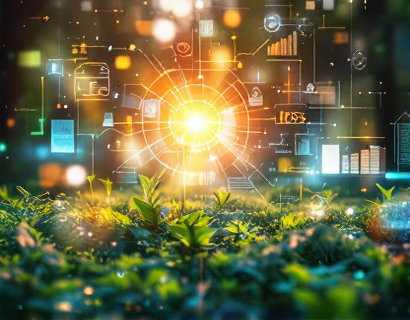Advanced Analytics for Sustainable Horticulture: Optimizing Resource Management and Enhancing Crop Yields
In recent years, the integration of advanced analytics in horticulture has emerged as a pivotal strategy for achieving sustainability and efficiency in agricultural practices. The application of sophisticated environmental analytics software is transforming the way farmers and horticulturists manage resources and optimize crop yields. By leveraging data-driven insights, these tools are not only enhancing productivity but also promoting eco-friendly practices that contribute to a healthier planet.
The core of this transformation lies in the ability of advanced analytics to process vast amounts of data from various sources, including soil sensors, weather stations, and satellite imagery. This data is then analyzed to provide actionable insights that guide decision-making processes. For instance, precision agriculture techniques enabled by these analytics tools allow for the precise application of water, fertilizers, and pesticides, reducing waste and minimizing environmental impact.
Optimizing Resource Management
One of the primary benefits of advanced analytics in horticulture is the optimization of resource management. Traditional farming methods often rely on fixed schedules and uniform application rates for resources such as water and fertilizers. However, this approach can lead to overuse or underuse, resulting in inefficiencies and environmental degradation. Advanced analytics changes this paradigm by providing real-time data that informs variable rate applications.
Soil moisture sensors, for example, can monitor the water content in different areas of a field, allowing for targeted irrigation. This ensures that each plant receives the exact amount of water it needs, reducing water wastage and preventing over-saturation that can lead to root diseases. Similarly, nutrient sensors can detect the specific nutrient levels in the soil, enabling farmers to apply fertilizers more precisely. This not only saves on costs but also reduces the risk of nutrient runoff, which can pollute nearby water bodies.
Enhancing Crop Yields
Enhancing crop yields is another significant advantage of using advanced analytics in horticulture. By analyzing historical and real-time data, farmers can identify patterns and trends that influence crop growth and productivity. Machine learning algorithms can predict optimal planting times, ideal crop varieties for specific conditions, and the best management practices to maximize yields.
For instance, temperature and humidity data can be used to model the growth stages of crops and predict potential stress factors such as heat or frost. This allows farmers to take proactive measures, such as adjusting irrigation schedules or applying protective covers, to mitigate these risks. Additionally, analytics can help in monitoring plant health through drone imagery and hyperspectral sensing, enabling early detection of diseases and pests. Early intervention can prevent widespread infestations and maintain high crop quality.
Promoting Sustainable Practices
The use of advanced analytics in horticulture is inherently aligned with sustainable practices. By optimizing resource use and reducing waste, these tools help farmers minimize their environmental footprint. Sustainable agriculture aims to meet the needs of the present without compromising the ability of future generations to meet their own needs. Advanced analytics plays a crucial role in this goal by providing the data and insights necessary for informed, sustainable decision-making.
One key aspect of sustainability is soil health. Advanced analytics can monitor soil conditions over time, providing insights into soil degradation and suggesting practices to improve soil fertility and structure. For example, data on organic matter content, pH levels, and microbial activity can guide the use of cover crops and organic amendments. This not only enhances soil health but also increases its resilience to climate change.
Another sustainable practice facilitated by analytics is integrated pest management (IPM). By analyzing data on pest populations, weather conditions, and crop vulnerability, farmers can implement targeted pest control measures. This reduces the reliance on chemical pesticides, which can harm beneficial insects and contaminate the environment. IPM strategies supported by analytics lead to a more balanced ecosystem and healthier crops.
Case Studies and Real-World Applications
Several case studies demonstrate the effectiveness of advanced analytics in sustainable horticulture. In one example, a large-scale vegetable farm implemented a precision irrigation system based on real-time soil moisture data. The result was a 30% reduction in water usage without compromising crop yields. Another case involved a fruit orchard that used drone-based monitoring to detect early signs of fruit diseases. This allowed for timely treatment, reducing the need for broad-spectrum fungicides and increasing the overall quality of the harvest.
These successes highlight the potential of advanced analytics to transform horticultural practices. By providing precise, data-driven insights, these tools empower farmers to make more sustainable and profitable decisions.
Challenges and Future Directions
Despite the numerous benefits, the adoption of advanced analytics in horticulture faces several challenges. One major hurdle is the initial cost of implementing these technologies, which can be prohibitive for small-scale farmers. Additionally, there is a need for skilled personnel who can interpret the data and implement the recommended practices. To address these challenges, initiatives to provide affordable technology solutions and training programs are essential.
Looking ahead, the future of advanced analytics in horticulture is promising. The integration of artificial intelligence and the Internet of Things (IoT) is expected to further enhance the capabilities of these systems. For instance, AI can improve the accuracy of predictive models and automate decision-making processes. IoT devices will continue to provide real-time data from the field, creating a more connected and responsive agricultural ecosystem.
Moreover, the development of user-friendly platforms and interfaces will make these advanced tools more accessible to a broader range of farmers. This democratization of technology will ensure that the benefits of advanced analytics are available to all, regardless of the size of the operation.
Conclusion
Advanced analytics is revolutionizing sustainable horticulture by optimizing resource management and enhancing crop yields through data-driven insights. The ability to monitor and manage resources precisely not only improves productivity but also promotes environmentally friendly practices. As the technology continues to evolve, it holds the potential to create a more sustainable and resilient agricultural sector. By embracing these advanced tools, farmers and horticulturists can contribute to a healthier planet while ensuring food security for future generations.










































